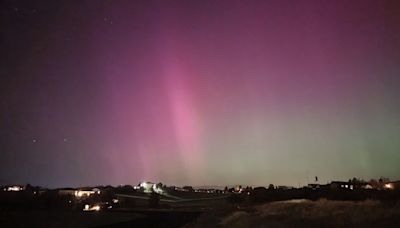Search results
Colorado is nicknamed the "Centennial State" because it became a state one century (and four weeks) after the signing of the United States Declaration of Independence . Denver is the capital, the most populous city, and the center of the Front Range Urban Corridor. Colorado Springs is the second most populous city.
- United States Congressional Delegations From Colorado
Since Colorado became a U.S. state in 1876, it has sent...
- List of Counties in Colorado
The U.S. State of Colorado is divided into 64 counties.Two...
- Jared Polis
Jared Schutz Polis (/ ˈ p oʊ l ɪ s /; born May 12, 1975) is...
- El Paso County, Colorado
An isolated rural house next to a mountain in northern El...
- Colorado Eastern Plains
In Eastern Colorado most small towns have their own schools...
- U.S. Senators
Colorado was admitted to the Union on August 1, 1876 and...
- House of Representatives
The Colorado House of Representatives is the lower house of...
- Colorado General Assembly
The Colorado General Assembly is the state legislature of...
- Territory of Colorado
The Territory of Colorado was an organized incorporated...
- List of United States Representatives From Colorado
The following is an alphabetical list of members of the...
- United States Congressional Delegations From Colorado
- Overview
- Relief and drainage
Colorado, constituent state of the United States of America. It is classified as one of the Mountain states, although only about half of its area lies in the Rocky Mountains. It borders Wyoming and Nebraska to the north, Nebraska and Kansas to the east, Oklahoma and New Mexico to the south, and Utah to the west. Colorado was admitted to the union on August 1, 1876, as the 38th state. The capital is Denver.
Colorado’s history is written in the names of its cities, towns, mountain ranges, and passes. Native American, French, and Spanish names alternate with those of frontier Americans, and many ghost towns are reminders of the thousands of prospectors and homesteaders who streamed into the territory in the mid-19th century to pursue dreams of gold, silver, and grain bonanzas. Vast cattle ranges and agricultural acreage fed by huge irrigation projects are characteristic of present-day Colorado, as are the diversified industries and the educational and research facilities in the state’s urban centres. Area 104,094 square miles (269,603 square km). Population (2020) 5,773,714; (2023 est.) 5,877,610.
Colorado’s natural landscape ranges from the flat grass-covered eastern plains—the High Plains of the Great Plains—through the rolling hilly Colorado Piedmont paralleling the Rocky Mountain front, to the high and numerous mountain ranges and plateaus in the western portion of the state that make up the southern Rocky Mountains and the Colorado Plateau. Within those areas the state rises from about 3,350 feet (1,020 metres) in elevation in the east to more than 14,000 feet (4,300 metres) in the Rockies.
Lack of water is the dominant characteristic of Colorado’s eastern plains region. The Arkansas and South Platte are the state’s major eastern rivers, but both rise in the mountains to the west. Many other rivers are dry during much of the year, and the land is flat to gently rolling. Underlain by layered rocks, sandstones, shales, and limestones covered by short-grass vegetation, the natural environment is inhabited by prairie dogs, jackrabbits, coyotes, rattlesnakes, antelope, and such birds as the meadowlark and the lark bunting. The climate, flatness, and layered rocks have produced fertile soils that lack only moisture. Nearly all the plains are covered by brown soils, which support a strong mat of buffalo and grama grass, a valued resource for cattle grazing.
Britannica Quiz
U.S. State Nicknames Quiz
About 50 miles (80 km) wide and 275 miles (440 km) long, the Colorado Piedmont is a picturesque hilly to mountainous landscape sandwiched between the plains and the mountains. It encompasses all the state’s large urban complexes, its major transport arteries, most of its industry, most of its major colleges and universities, and four-fifths of its people. The layered rocks have been uptilted and dissected into prominent stream divides and deep valleys by the major rivers and numerous smaller streams that discharge onto the piedmont from the mountains. The terrain, ground cover, and climatic conditions provide suitable habitats for rabbits, waterfowl, pheasants, coyotes, deer, raccoon, and, on the arid foothills and unirrigated uplands, rattlesnakes. Many species of birds prevail, of which the meadowlark, the crow, the dove, and the western magpie are most numerous. The climate and land of the Colorado Piedmont attract tourists, homeseekers, and, beyond the rapidly growing urban centres, farmers. The major cities and the wealthy farm areas both lie where the streams have broadened the valleys. Among the attractive features of the landscape is the agglomeration of high, dramatically shaped red sandstone formations northwest of Colorado Springs known as the Garden of the Gods. In the foothills southwest of Denver is one of the world’s largest and most-beautiful outdoor amphitheatres, Red Rocks Park and Amphitheatre. Since 1880 more than 400 reservoirs have been built in the piedmont to store water for irrigation. Those sites are meccas for water sports, hunting, and house building.
The western half of Colorado includes the huge mountain upthrust, comprising much of the southern Rocky Mountains and the Colorado Plateau, where mesas and mountain ranges alternate with broad intervening valleys and deep narrow canyons. With its copious precipitation, that mountain land provides water for six states and Mexico, principally via the Colorado River, which rises in the northern mountains and flows south and then west through the state until it enters eastern Utah. The drainage pattern from the Rockies is oriented by the mountains themselves, which form the Continental Divide, the main watershed boundary of the continent. The region west of the divide is commonly called the western slope.
The Territory of Colorado was a historic, organized territory of the United States that existed between 1861 and 1876. Its boundaries were identical to the current State of Colorado. The territory ceased to exist when Colorado was admitted to the Union as a state on August 1, 1876.
1 Boulder — Prominent research center at the foot of the Flatirons is home of the University of Colorado. 39.739167 -104.984722. 2 Denver — Founded as a placer mining camp, the "Mile-High City" is the state capital and the most populous city within 560 miles (900 km). 38.8333 -104.8167.
Colorado is the only U.S. state that lies entirely above 1,000 meters (3,281 ft) in height. Colorado has the highest average elevation of any state at 6,800 ft. It borders New Mexico, Arizona, Utah, Oklahoma, Kansas, Nebraska, and Wyoming. The land area of Colorado is roughly the same size as New Zealand. Climate
- August 1, 1876 (38th)
- United States
- Colorado Territory
Map of Colorado. Colorado map of Köppen climate classification. A digital elevation model relief map of Colorado. The geography of the U.S. State of Colorado is diverse, encompassing both rugged mountainous terrain, vast plains, desert lands, desert canyons, and mesas. Colorado is a landlocked U.S. state.
Colorado is a landlocked state in the Mountain West subregion of the Western United States. Colorado borders Wyoming to the north, Nebraska to the northeast, Kansas to the east, Oklahoma to the southeast, New Mexico to the south, Utah to the west, and meets Arizona to the southwest at the Four Corners.



